Własna strona umożliwia korzystanie z innego układu niż reszta twojej witryny internetowej. Wiele witryn WordPress korzysta z własnych układów stron dla stron sprzedaży, stron docelowych, stron webinarów i innych.
Przez lata stworzyliśmy wiele niestandardowych stron na WPBeginner do różnych celów. Używaliśmy ich do pokazywania różnych ofert na wtyczki i usługi hostingowe, oferowania usług Pro, aby pomóc użytkownikom w korzystaniu z WordPressa, wyświetlania różnych produktów i nie tylko.
Z naszego doświadczenia wynika, że istnieje wiele sposobów tworzenia niestandardowych stron. W niektórych naszych projektach korzystaliśmy z kreatorów stron, takich jak SeedProd. Poza tym można również użyć edytora bloków lub pełnych edytorów witryn, aby dodać niestandardowe strony do swojej witryny.
W tym artykule pokażemy, jak łatwo utworzyć własną stronę w WordPress.
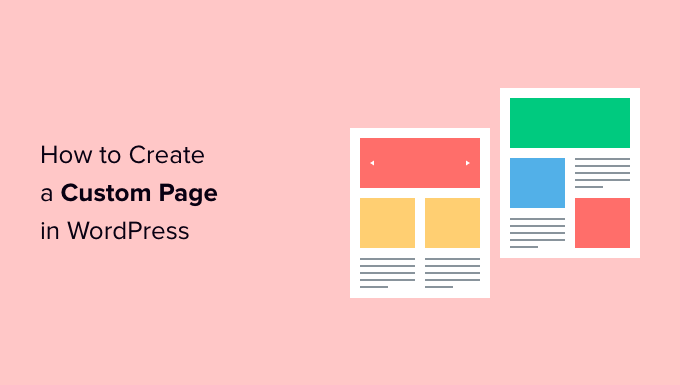
Dlaczego warto utworzyć własną stronę w WordPress?
Za każdym razem, gdy tworzysz nową stronę, motyw WordPress kontroluje jej wygląd za pomocą pliku szablonu.
Szablon page.php ma wpływ na wszystkie pojedyncze strony tworzone w WordPressie. Możesz jednak nie chcieć używać tego samego projektu za każdym razem.
Strony docelowe często mają inną zawartość niż zwykłe strony, takie jak duży obraz bohatera lub wezwanie do działania (CTA). Oznacza to, że często wyglądają zupełnie inaczej niż reszta witryny.
Jednak próba stworzenia unikatowych projektów przy użyciu standardowego szablonu strony może zająć dużo czasu. Jesteś również ograniczony przez szablon page.php i możesz nie być w stanie stworzyć dokładnie takiego projektu, jaki chcesz. Może to utrudnić uzyskanie dobrych wyników. Na przykład, jeśli tworzysz stronę sprzedażową, możesz nie uzyskać wielu konwersji z powodu złego projektu strony.
Mając to na uwadze, zobaczmy, jak utworzyć własną stronę w WordPressie, z dokładnym projektem, układem i treścią, którą chcesz. Skorzystaj z poniższych odnośników, aby przejść bezpośrednio do wybranej metody.
- Method 1. How to Create a Custom Page in WordPress Using the Block Editor (No Plugin Required)
- Method 2. How to Create a Custom Page Using the Full-Site Editor (Block-Based Themes Only)
- Method 3. Create a Custom Page in WordPress using SeedProd (Recommended)
- Method 4. Using Thrive Architect to Create a Custom Page in WordPress
Metoda 1. Jak utworzyć własną stronę w WordPressie za pomocą edytora bloków (bez wtyczki)?
Edytor bloków ułatwia projektowanie własnych szablonów przy użyciu narzędzi, które już znasz.
Jest to dobry wybór, jeśli planujesz ponownie wykorzystać ten sam projekt na wielu stronach, ponieważ możesz po prostu zastosować ten sam szablon. Jeśli chcesz stworzyć całkowicie unikatowy projekt, inną opcją jest utworzenie strony w normalny sposób, a następnie edytowanie jej układu za pomocą edytora całej witryny, który omówimy w Metodzie 2.
Należy tylko pamiętać, że metody te działają tylko z motywami opartymi na blokach, takimi jak ThemeIsle Hestia Pro lub Twenty Twenty-Three. Jeśli nie posiadasz motywu blokowego, zalecamy skorzystanie z kreatora stron.
Aby rozpocząć, wystarczy otworzyć dowolną stronę lub wpis. Następnie wybierz kartę “Strona” w menu po prawej stronie i kliknij tekst obok “Szablon”.
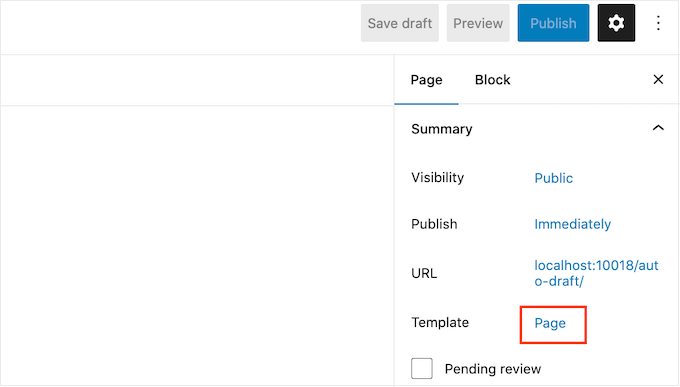
Opcje, które zobaczysz, mogą się różnić w zależności od twojego motywu WordPress, ale tekst będzie zazwyczaj pokazywał “Stronę”, “Domyślny szablon” lub podobny.
W wyświetlonym oknie kliknij ikonkę “Dodaj szablon”.
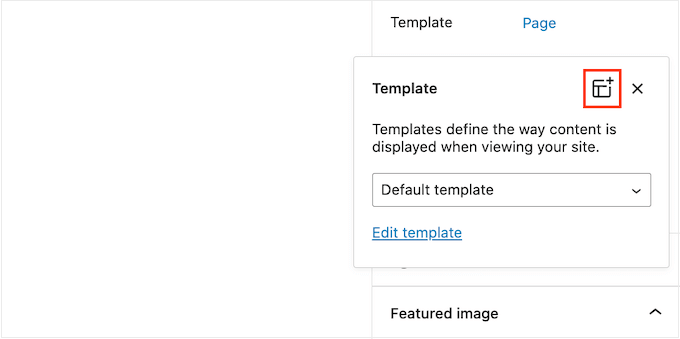
W wyświetlonym oknie wpisz rodzaj nazwy twojego szablonu, a następnie kliknij przycisk “Utwórz”.
Nazwa jest tylko dla twojego odniesienia, więc możesz użyć czegokolwiek chcesz.
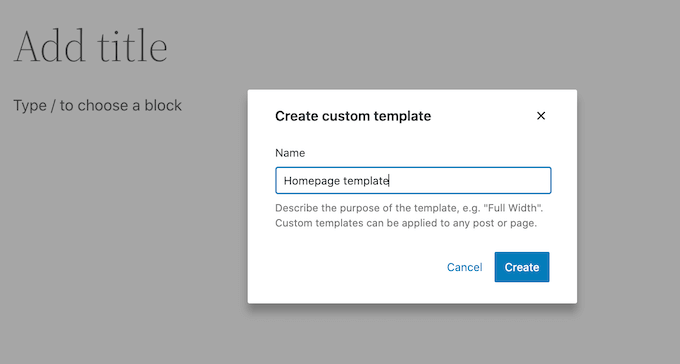
Spowoduje to uruchomienie edytora szablonów, który działa podobnie do edytora treści WordPress.
Aby dodać bloki do własnego projektu strony, wystarczy kliknąć niebieski przycisk “+”. Następnie możesz przeciągnąć i upuścić, aby dodać bloki.
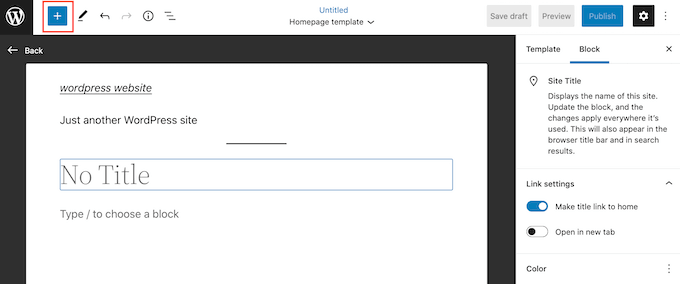
Możesz dodać treść do bloku lub zmienić jego formatowanie za pomocą znanych narzędzi do edycji wpisów WordPress. Na przykład, możesz wpisać rodzaj tekstu do bloku “Nagłówek”, zastosować pogrubienie lub zmienić tekst z H2 na H3.
Własną stronę można również utworzyć przy użyciu wzorców. Wzorce to kolekcje bloków, które są często używane razem, takie jak lista wydarzeń, obrazek z podpisem lub tabela cen.
Widoczne wzorce będą się różnić w zależności od twojego motywu WordPress, ale możesz zobaczyć, które wzorce są dostępne, klikając kartę “Wzorce”.
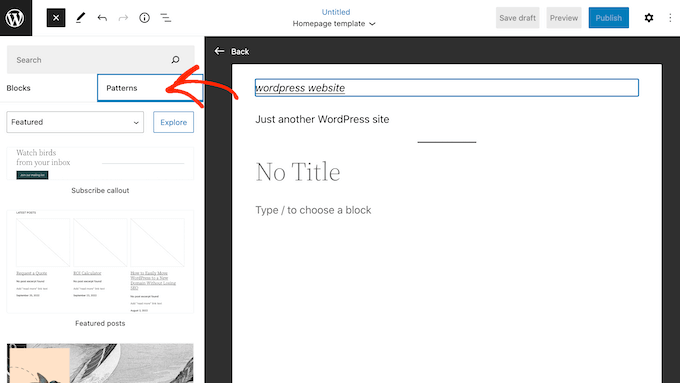
Możesz przeciągnąć i upuścić wzorzec bloku na twój układ lub kliknąć na wzorzec, aby dodać go na dole szablonu. Gdy będziesz zadowolony z wyglądu szablonu, kliknij przycisk “Opublikuj”, a następnie “Zapisz”.
Możesz teraz zastosować ten szablon do dowolnej strony. Wystarczy otworzyć stronę w edytorze, a następnie kliknąć tekst obok “Szablon”.
W wyświetlonym oknie wybierz szablon, który właśnie utworzyłeś.
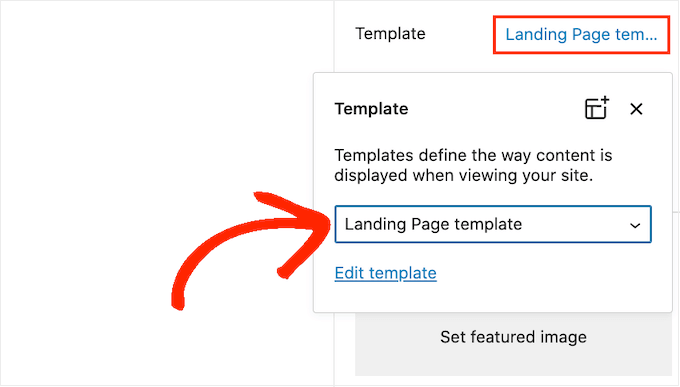
Po wykonaniu tej czynności można dodać treść do strony, tak jak w przypadku każdej innej strony WordPress.
Metoda 2. Jak utworzyć własną stronęza pomocą edytora całej witryny (tylko motywy blokowe)
Jeśli korzystasz z motywu opartego na blokach, możesz również utworzyć własną stronę za pomocą edytora całej witryny. Pozwala to na zmianę układu pojedynczej strony bez konieczności tworzenia własnego szablonu.
Mając to na uwadze, jest to dobry wybór, jeśli chcesz stworzyć całkowicie unikatowy projekt, którego nie wykorzystasz ponownie na żadnej innej stronie.
Aby rozpocząć, wystarczy utworzyć stronę w zwykły sposób, przechodząc do Strony “ Utwórz nową. Następnie możesz wpisać tytuł, dodać kategorie i tagi, przesłać obrazek wyróżniający i wprowadzić dowolne inne zmiany.
Kiedy będziesz zadowolony z wyglądu twojej strony, zapisz zmiany i przejdź do sekcji Wygląd “ Edytor.
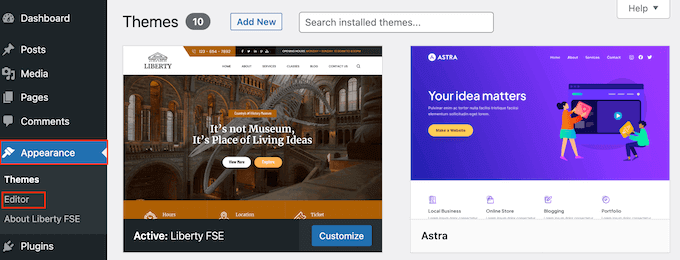
Domyślnie w pełnym edytorze witryny wyświetlany jest szablon główny twojego motywu.
W menu po lewej stronie kliknij “Strony”.
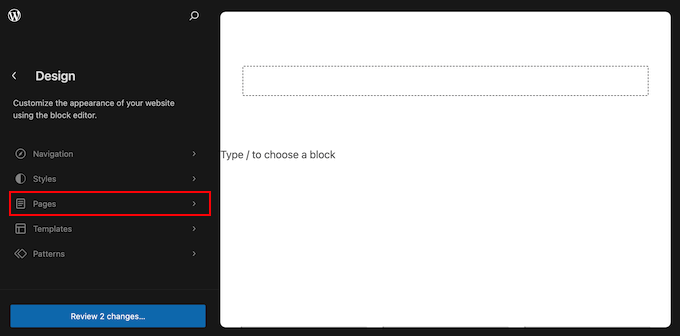
Zobaczysz teraz wszystkie strony, które utworzyłeś w swojej witrynie internetowej WordPress.
Po prostu znajdź stronę, którą chcesz przeprojektować i kliknij ją.
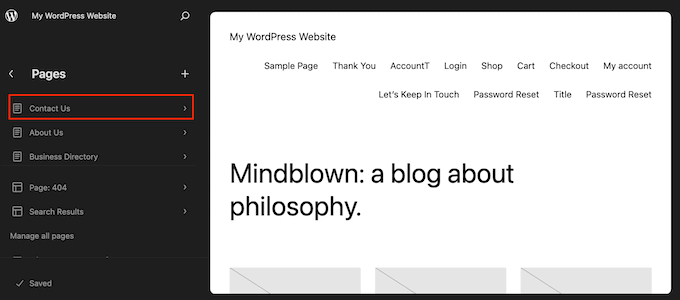
WordPress wyświetli teraz podgląd projektu.
Aby przejść dalej i edytować ten szablon, kliknij małą ikonkę ołówka.
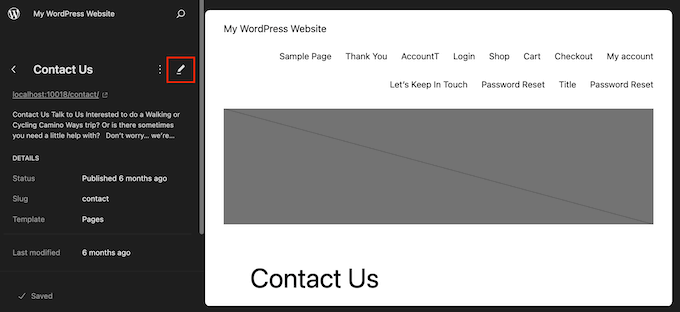
Możesz teraz edytować układ strony za pomocą narzędzi edytora na całej witrynie. Możesz na przykład kliknąć niebieski przycisk “+”, aby utworzyć nowe bloki, lub kliknąć, aby wybrać dowolny blok, który chcesz dostosować.
Gdy będziesz zadowolony z wprowadzonych zmian, kliknij przycisk “Zapisz”.
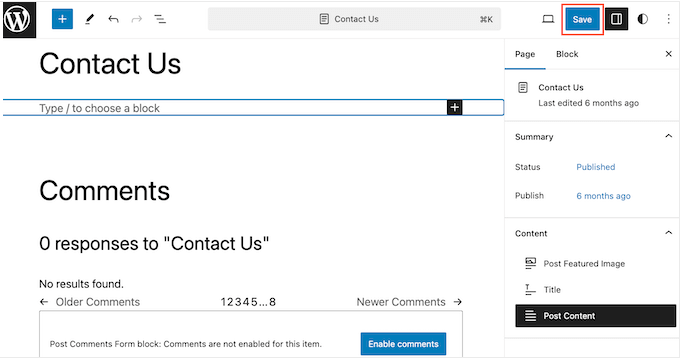
Teraz, jeśli przejdziesz na tę stronę w twojej witrynie internetowej, zobaczysz nowy wygląd strony w działaniu.
Metoda 3. Utwórz własną stronę w WordPress za pomocą SeedProd (zalecane)
W przeszłości tworzenie własnej strony polegało na pisaniu kodu, co nie było zbyt przyjazne dla początkujących. Jeśli popełniłeś błąd w kodzie HTML, CSS lub PHP, może to spowodować typowe błędy WordPressa lub nawet całkowicie zepsuć twoją witrynę.
Mając to na uwadze, zalecamy skorzystanie z kreatora stron.
SeedProd to najlepszy kreator stron typu “przeciągnij i upuść ” dla WordPress. Zawiera ponad 350 szablonów, umożliwiając tworzenie własnych stron bez pisania jakiegokolwiek kodu.
Jeśli korzystasz z niestandardowej strony, aby uzyskać więcej konwersji, SeedProd współpracuje z wieloma popularnymi narzędziami innych firm, których możesz już używać do uzyskiwania konwersji. Obejmuje to najlepsze usługi e-mail marketingu, WooCommerce, Google Analytics i inne.
Najpierw należy zainstalować i włączyć SeedProd. Aby uzyskać więcej informacji, zobacz nasz przewodnik krok po kroku, jak zainstalować wtyczkę WordPress.
Uwaga: Istnieje również darmowa wersja SeedProd, która umożliwia tworzenie własnych stron bez względu na twój budżet. Jednak na potrzeby tego przewodnika będziemy używać SeedProd Pro, ponieważ ma on o wiele więcej szablonów i integruje się ze wszystkimi najlepszymi usługami e-mail marketingu.
Po włączaniu wtyczki, SeedProd poprosi o twój klucz licencyjny.

Informacje te można znaleźć na Twoim koncie w witrynie internetowej SeedProd. Po wpiszeniu klucza kliknij przycisk “Zweryfikuj klucz”.
Wybór własnego szablonu strony
Gdy już to zrobisz, przejdź do SeedProd ” Landing Pages i kliknij przycisk “Utwórz nową stronę docelową”.
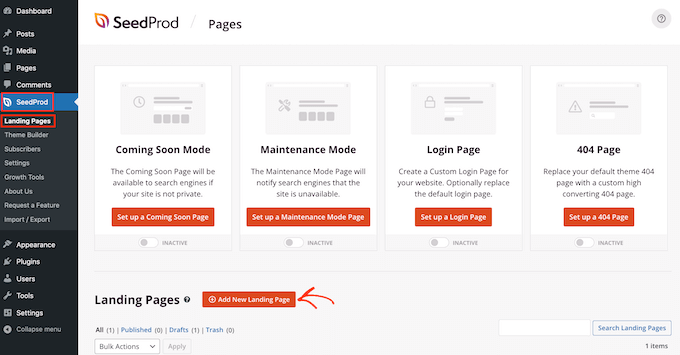
Możesz teraz wybrać szablon dla twojej własnej strony.
Szablony SeedProd są podzielone na różne typy kampanii, takie jak “lead”,“squeeze” i“coming soon“. Możesz kliknąć karty w górnej części ekranu, aby filtrować szablony na podstawie typu kampanii.
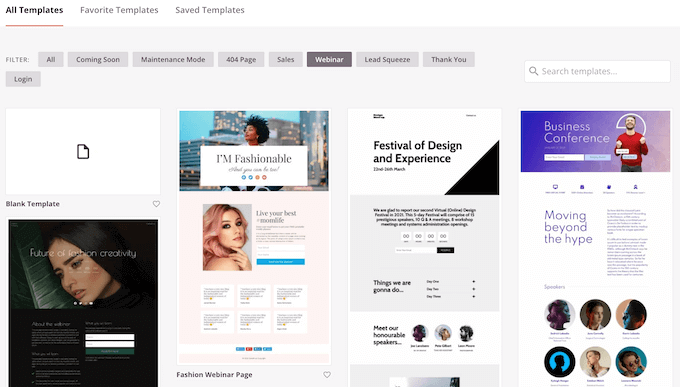
Jeśli chcesz zacząć od zera, SeedProd ma również pusty szablon, którego możesz użyć.
Aby przyjrzeć się bliżej dowolnemu szablonowi, po prostu najedź na niego kursorem myszy, a następnie kliknij ikonkę lupy.
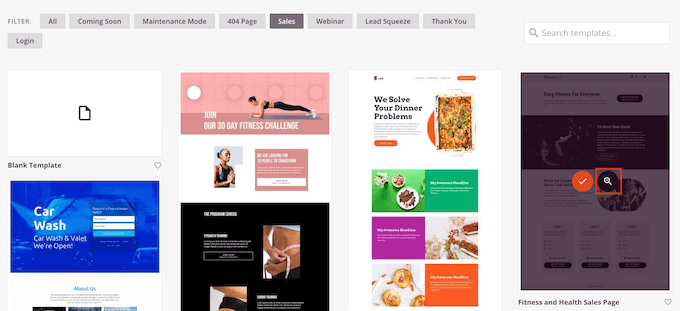
Gdy znajdziesz projekt, który Ci się podoba, kliknij “Wybierz ten szablon”. We wszystkich naszych obrazkach używamy szablonu “Course Sales Page”, ale możesz użyć dowolnego szablonu.
Następnie wpisz rodzaj nazwy dla własnej strony. SeedProd automatycznie utworzy adres URL na podstawie tytułu strony, ale możesz go zmienić na dowolny inny.
Opisowy adres URL pomoże również wyszukiwarkom zrozumieć, o czym jest strona, dzięki czemu będą mogły pokazać ją właściwym użytkownikom, co poprawi twoje SEO WordPress.
Aby dać twojemu konfiguratorowi najlepszą szansę na pojawienie się w odpowiednich wynikach wyszukiwania, możesz dodać słowa kluczowe, których brakuje w adresie URL. Aby uzyskać więcej informacji, zapoznaj się z naszym przewodnikiem na temat badania słów kluczowych.
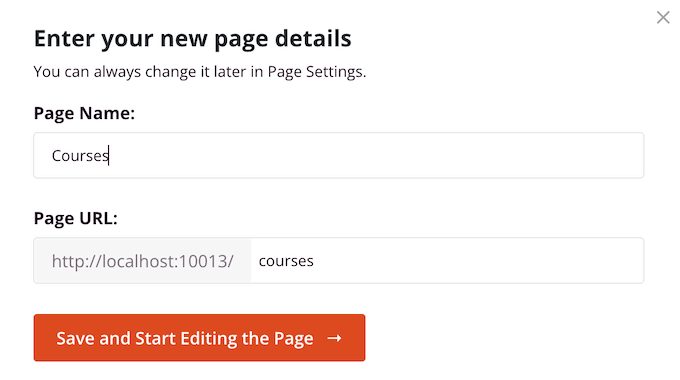
Gdy jesteś zadowolony z informacji, które wpiszesz, kliknij przycisk “Zapisz i rozpocznij edycję strony”.
Zaprojektuj swoją własną stronę
SeedProd otworzy teraz twój wybrany szablon w przyjaznym dla użytkownika edytorze przeciągnij i upuść. Po prawej stronie zobaczysz podgląd na żywo twojej strony, a po lewej niektóre ustawienia bloków.

Aby dostosować blok, wystarczy kliknąć, aby wybrać go w edytorze strony. Lewy pasek narzędzi pokaże wszystkie ustawienia dla tego bloku.
Na poniższym obrazku zmieniamy tekst wewnątrz bloku “Nagłówek”.
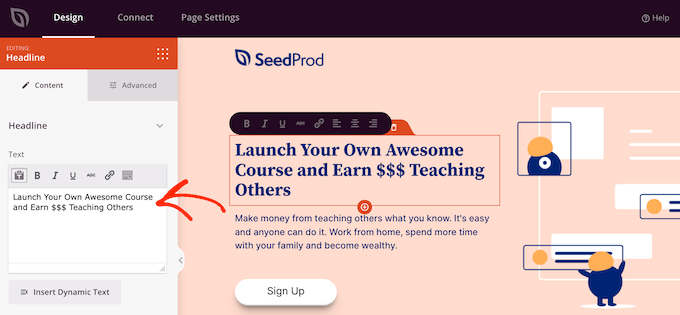
Możesz formatować tekst, zmieniać jego wyrównanie, dodawać odnośniki i nie tylko, korzystając z ustawień w menu po lewej stronie.
Łatwo jest również edytować obrazki za pomocą kreatora stron SeedProd. Wystarczy kliknąć dowolny blok “Obrazek” i użyć ustawień, aby dodać tekst alternatywny, utworzyć nowy obrazek lub wprowadzić inne zmiany.
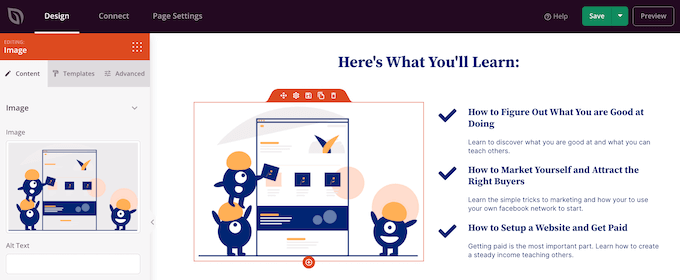
Jeśli chcesz usunąć blok z własnej strony, po prostu kliknij, aby wybrać ten blok.
Następnie kliknij ikonkę kosza na mini pasku narzędzi.
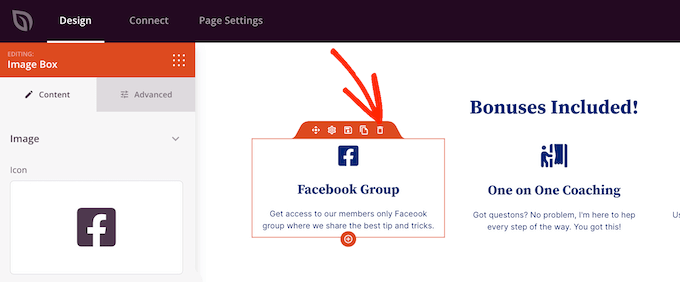
Aby utworzyć nowe bloki do twojego projektu, po prostu znajdź blok w menu po lewej stronie, a następnie przeciągnij go do edytora.
Następnie możesz kliknąć, aby wybrać blok i wprowadzić zmiany w menu po lewej stronie.
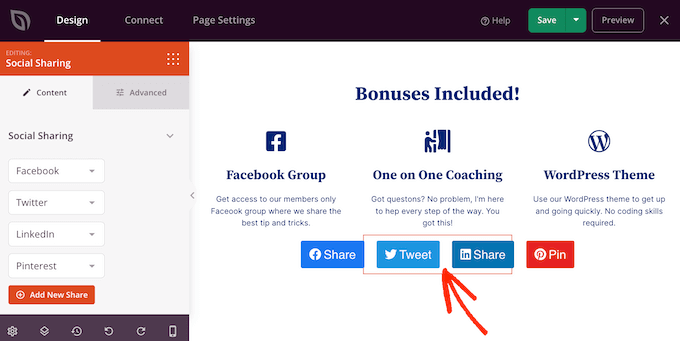
SeedProd zawiera również “Sekcje”, które są szablonami wierszy i bloków, które mogą pomóc w szybkim utworzeniu własnej strony. Na przykład, jeśli projektujesz stronę docelową Google Ad, możesz użyć gotowych sekcji Hero, Call To Action lub funkcji SeedProd.
Aby zobaczyć wszystkie dostępne sekcje, wystarczy kliknąć kartę “Sekcje”.
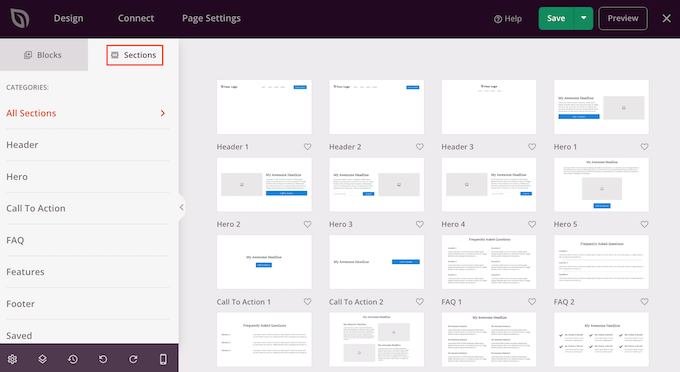
Aby dokładniej przyjrzeć się danej sekcji, najedź na nią kursorem myszy, a następnie kliknij ikonkę lupy.
Gdy znajdziesz sekcję, którą chcesz dodać do twojego projektu, po prostu najedź na nią myszką, a następnie kliknij małą ikonkę “+”.
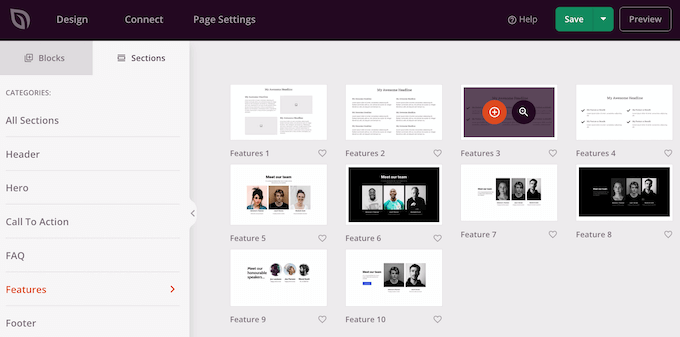
Spowoduje to dodanie sekcji na dole twojej strony. Możesz przenosić zarówno sekcje, jak i bloki wokół twojego projektu za pomocą przeciągania i upuszczania.
Jeśli popełnisz błąd lub zmienisz zdanie, nie martw się. Możesz cofnąć twoją ostatnią zmianę, klikając przycisk “Cofnij” u dołu lewego paska narzędzi.
Znajdziesz tu również przycisk ponawiania, historię wersji, nawigację po układzie i ustawienia globalne.
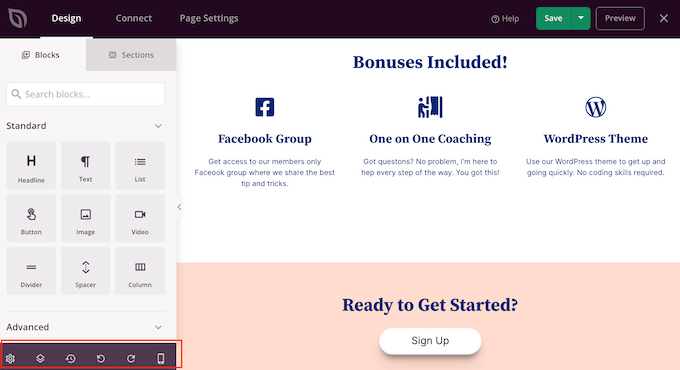
Te dodatkowe przyciski ułatwiają tworzenie własnych stron w WordPress.
W dolnej części paska narzędzi znajduje się również przycisk podglądu mobilnego, który pozwala zobaczyć mobilną wersję dostosowanej strony.
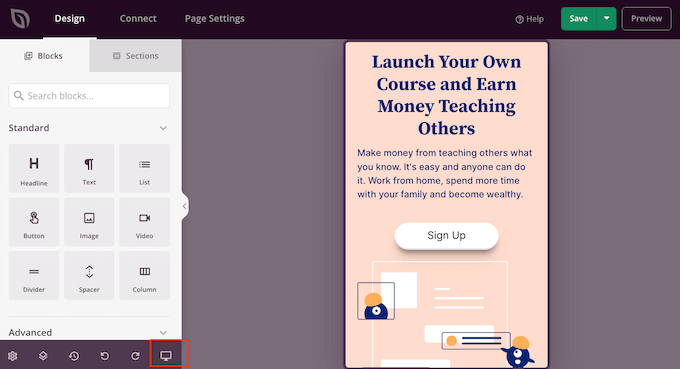
Może to pomóc w zaprojektowaniu własnej strony, która wygląda równie dobrze na urządzeniach mobilnych, jak i na twoim komputerze.
Kiedy jesteś zadowolony z własnego konfiguratora, nadszedł czas, aby go opublikować, klikając strzałkę rozwijaną obok “Zapisz”, a następnie wybierając opcję “Opublikuj”.
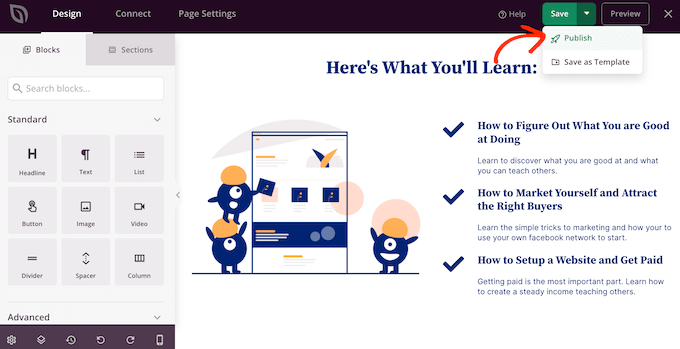
Twoja niestandardowa strona zostanie teraz uruchomiona na Twoim blogu WordPress.
Jeśli chcesz edytować własną stronę w dowolnym momencie, po prostu przejdź do SeedProd ” Landing Pages w Twoim kokpicie WordPress. Następnie znajdź stronę, którą chcesz zmienić i kliknij odnośnik “Edytuj”.
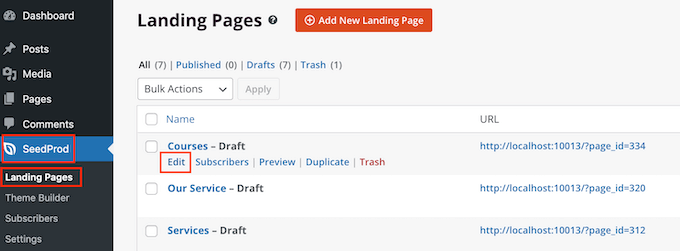
Spowoduje to otwarcie projektu w edytorze SeedProd, gotowego do wprowadzenia twoich zmian.
Metoda 4. Użycie Thrive Architect do stworzenia własnej strony w WordPressie
Możesz również utworzyć własną stronę za pomocą Thrive Architect. Thrive Architect to kolejny popularny kreator stron typu “przeciągnij i upuść” dla WordPress.
Zawiera ponad 300 profesjonalnie zaprojektowanych szablonów, które mają pomóc w uzyskaniu większej liczby konwersji.

Najpierw należy zainstalować i włączyć wtyczkę Thrive Architect. Aby uzyskać więcej informacji, zapoznaj się z naszym przewodnikiem krok po kroku, jak zainstalować wtyczkę WordPress.
Po włączeniu, przejdź do Pages ” Add New w kokpicie administracyjnym WordPress, aby utworzyć konfigurator własnej strony. Następnie kliknij przycisk “Launch Thrive Architect”.
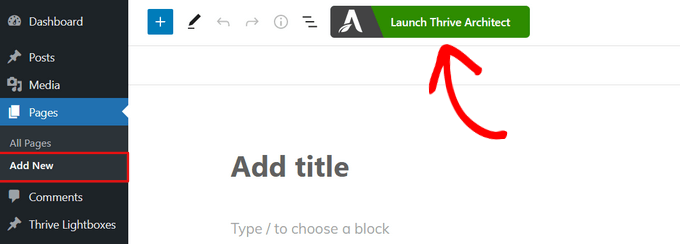
Następnie możesz wybrać, czy chcesz utworzyć normalną stronę, czy gotową stronę docelową.
Zalecamy kliknięcie na “Pre-built Landing Page”, ponieważ daje to dostęp do wszystkich szablonów stron docelowych Thrive. Szablony te są w pełni konfigurowalne, więc możesz je dostosować do swojej witryny WordPress.
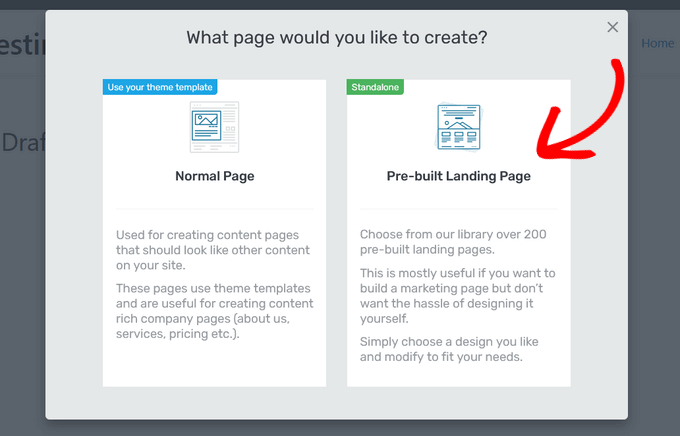
Gdy znajdziesz zestaw, który Ci się podoba, po prostu kliknij, aby go wybrać.
Na poniższym obrazku wybieramy “Inteligentne zestawy stron docelowych”.
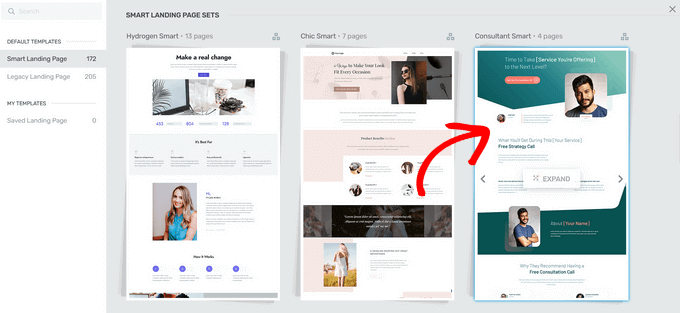
Na kolejnym ekranie należy wybrać konkretny szablon z zestawu.
Wybierz szablon, klikając go, a następnie naciskając przycisk “Zastosuj szablon”.
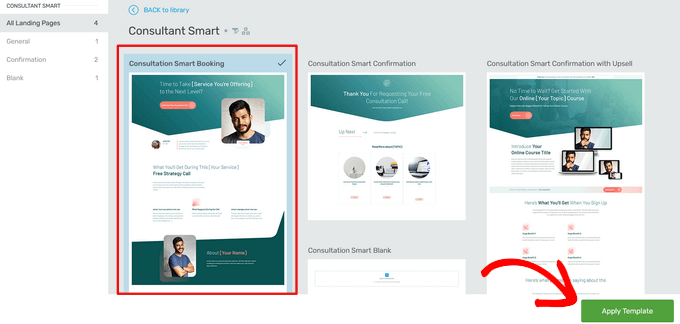
Spowoduje to otwarcie szablonu w edytorze Thrive Architect. Stąd możesz łatwo dostosować szablon strony do twojego bloga, witryny internetowej lub sklepu internetowego.
Na przykład, można zmienić “Nagłówek” klikając na niego, a następnie wpisując Twój własny, dostosowany komunikat.
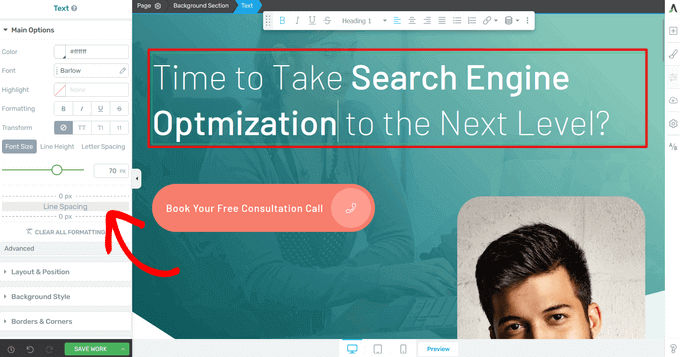
W menu po lewej stronie zobaczysz teraz wszystkie opcje konfiguratora. Tutaj możesz zmienić typografię, wielkość liter, kolor, formatowanie i wiele więcej.
W panelu po lewej stronie można również dostosować inne ustawienia własnej strony, takie jak układ, styl tła, obramowania, animacje i zachowanie przewijania, by wymienić tylko kilka z nich.
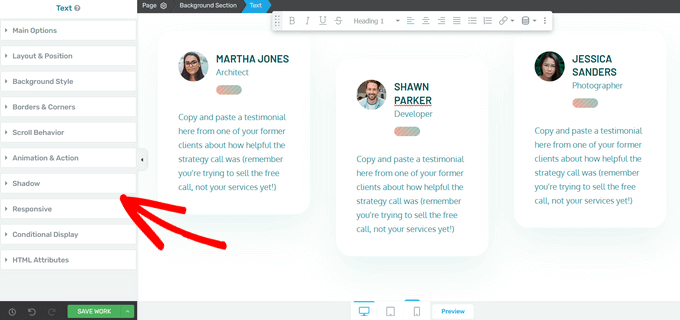
Podobnie jak bloki SeedProd, Thrive Architect zawiera wiele gotowych elementów, które możesz dodać do swojego konfiguratora.
Aby utworzyć nowy element na stronie, kliknij przycisk “Dodaj element (+)” po prawej stronie ekranu.
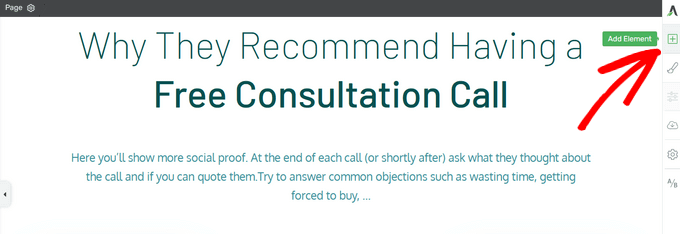
Możesz teraz wybierać spośród takich elementów jak obrazy, przyciski, formularze generowania leadów, tabele cenowe, liczniki czasu i inne.
Aby dodać element, wystarczy przeciągnąć go z menu po prawej stronie i upuścić na twojej stronie.
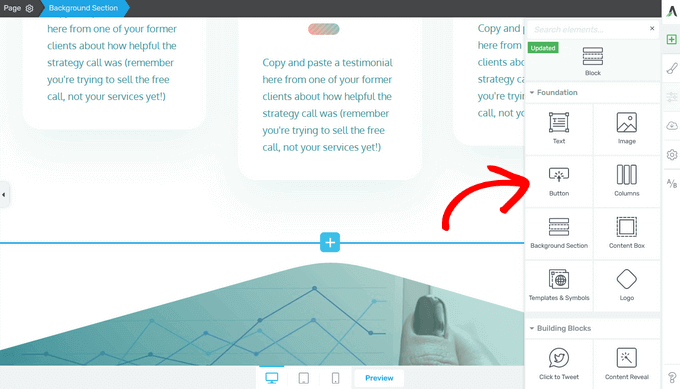
Ponownie, możesz edytować każdy z nowych elementów, które utworzysz na swojej stronie, klikając je.
Kiedy będziesz zadowolony z wyglądu strony, kliknij przycisk strzałki (^) obok przycisku “Zapisz pracę”. Następnie kliknij opcję “Zapisz i wróć do edytora wpisów”.
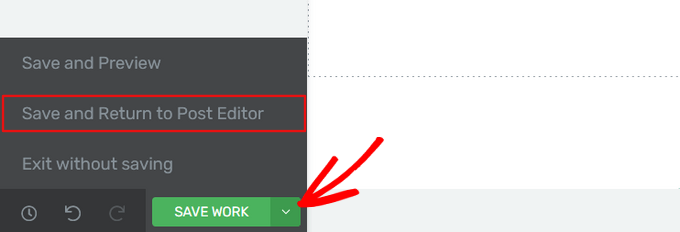
Następnie możesz zapisać stronę jako wersję roboczą lub opublikować ją, aby pojawiła się na twojej witrynie internetowej WordPress.
Po opublikowaniu twojego konfiguratora możesz przejść na twoją witrynę, aby zobaczyć go w działaniu.
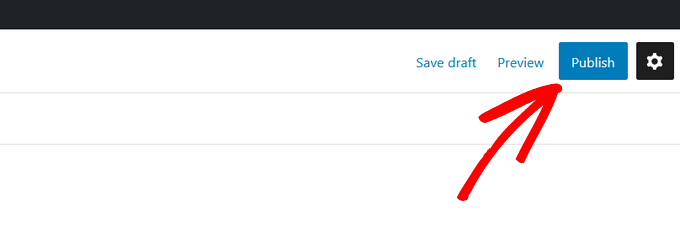
Mamy nadzieję, że ten artykuł pomógł ci dowiedzieć się, jak utworzyć niestandardową stronę w WordPress. Możesz również zapoznać się z naszym przewodnikiem na temat tworzenia strony docelowej w WordPress i dzielenia tytułu postu lub strony w WordPress.
If you liked this article, then please subscribe to our YouTube Channel for WordPress video tutorials. You can also find us on Twitter and Facebook.





NG SHAIKH
Dear WPB Team,
I created the template named MyTemplate.php and copied it into /wp-content/themes/ directory. The template is not reflected in drop down menu of Page Attribute -> Templets. Please guide.
Is it necessary to use FTP server for this? Please guide.
Thanks.
NG SHAIKH
NG SHAIKH
Kudos to WPBeginner Team. This is an excellent article which can give guidance to a beginner from the scratch. What a help!
However, if there is further guidance as to how to remove sidebar, create and add custom sidebar and where to put PHP code or HTML.
With lot of regards and love,
NG SHAIKH
Ajay
Hi great tutorial!
One question… I am adding new HTML template files that use css and js files etc. How can I link these files in my template file? I added the files to the same directory as the other stylesheets and assets but no luck. They do not render on the new template page. Any ideas?
Thanks!
The Last One
Im confused.. i hink this site has written years ago, but if i do understand it, you cannot do custom pages anymore in wordpress unless you have some sort of subscription?
i was trying to “edit” my wordpress site but all feature was missing.
Rob
Thanks – once again – how to remove header/footer/sidebar?
Thanks
Editorial Staff
Remove get_sidebar(), get_footer(), and get_header().
This will break all the styling because your stylesheet won’t load. So you need to make sure that wp_head() and wp_footer() are added in your template.
Fore more customization help, you may want to look here:
https://codex.wordpress.org/Theme_Development
Admin
Jeff
thanks great help
Deepan
Thanks for this tutorial,this tutorial help me to understand the concept easily.Good Work keep continuing like this.
-Deepan
tony kh tan
Thank you for this tutorial. I use cPanel to add the customPage.php onto wp-content/.. and it works. Without using FTP.
Njoroge Mathu
Thanks for the great article. Tried the steps and it works perfect. Seems like the file ‘CustomPageT1.php’ has to always be uploaded into the active theme folder or if working offline with wamp save it in wamp/www/wordpress/wp-content/themes/active theme.
Amit Prasad
Great Article. Exactly what I was looking for. Keep up the good work pal!
Osvaldo
This article, pure and simple, works like charm to me!!!
Jean-Charles de Geekarts
So it works perfectly bur when I put the file in a plugin file (because it make more sense) it doesn’t work. Do you have anyidea on what to do to make it work.
Thanks anyway for all your great tutorial
Ronny
Great work, guys. Thank you very much. But one question please… How do i make this custom template pull posts from one particular category or categories? I’ve been building websites with wordpress for a while now but, this one seems knotty to me. I know there’s a plugin that does this, but I’ll rather go with the custom template method. Thanks, again…
Chadly
hey guys, is their a plugin you recommend for WP that creates great looking pages like this:
You know, the pages that have the arrows pointing to things and almost a hand drawn look about the page.
Thanks…
irfan
Sir my websites homepage is in the form of custom link in wordpress menu and is not present in all pages also.I am a totaly newbie in website development so kindly help to convet this custom link into a page.
2:kindly also help to remove read more from posts.
Thanks
Irfan
website Address:www.fishysms.com
karlonc
Does this tutorial still apply to the newest wordpress?
Also will it keep any of the attributes of the theme you are using?
WPBeginner Support
Yes, it applies on latest WordPress and will keep all attributes of the theme you are using.
Admin
Musarrof
Please give details more and write it easily with screenshot. new word-press user cant understand your reading tutorial.
WPBeginner Support
Thanks for your feedback. Please let us know which part you did not understand and we will try to explain it.
Admin
Carol H.
I didn’t understand this part…
Once you have completed editing this file save it and upload it in your theme directory (/wp-content/themes/yourthemedirectory/) where files like single.php and index.php are located.
How does one upload to one’s theme directory? (I have a wordpress.com site; does this have anything to do with this?)
WPBeginner Support
Yes, you cannot upload files on WordPress.com sites. Please take a look at our guide on the difference between WordPress.com and Self hosted WordPress.org sites.
vinay
Hi,
where do we find the pages that were created with the add-new page link in wordpress.could someone help me out to figure out the pages.Thanks in advance
terance perera
go to appearance -> editor -> then you can see page templete or page.php
Joanna Gasdogas
oops. please ignore previous note.
Thank you for these instructions.
I have followed all your instructions, I believe correctly. However when I go to my WP editor to add content to this new template, nothing shows up on the page. It remains as a completely blank page.
kuldeep
how to create a simple template in wordpress
Joanna Gasdogas
Thank you for this. I followed all the instructions. I have a blank template now. But when I go to my wp editor to add content, the content doesn’t appear in the new page.
Samsher
Hey plz upload snap shot..
Marow95
How can I change the url ?
I mean instead of “blog/?page_id=2” , I want it to be “blog/about” .
Thanks in advance
WPBeginner Staff
Check out our guide on how to create SEO friendly URL Structure in WordPress.
Asim
Checkout Permalinks at the very beginning of the page.
Kikky
hallo, thanks for the post on creating a custom template, its helped greatly. But i have some issues i need answers to, this is my first time at wordpress and on the site i’m creating, i already have a custom template as the home page and then i have another page (with the theme’s initial homepage look, which is a custom page). the challenge i’m having now is : i want the custom template page i designed to load first but the theme’s custom page keeps coming up instead. i figured there’s some sort of conflict going on since they both have thesame url …so, preeeetyyy please, how do i get through this huge problem…thanks
WPBeginner Support
Seems like you resolved your problem. In this case, you could have specifically told WordPress to use a template for a specific page. For example if you wanted to create a custom template for http://www.example.com/home-2 then you name your template file to be page-home-2.php. You can also use a page’s id in the template, like page-33.php will only work on page with 33 as the unique id.
Admin
Pol Alvarez
Hi! I have always coded my webpages from scratch but now I need to add one to a wordpress website. I mean I have good html/css and this kind of stuff but little of wordpress.
I have followed the instructions and succesfully uploaded the file. The problem is that it is not listed on the template dropdown. I am not sure whether this happens because the file I created is not valid or any other problem. My file is composed of your header
and then following it a normal webpage (opening with etc…) without any styles now external files (just to check it out).
What am I doing wrong? any help would be appreciated.
Thanks you are my last resort!
WPBeginner Support
Pol, we can provide you some tips to troubleshoot.
Please study the file page.php in your theme’s directory. Your custom page template should follow the same structure as page.php except the header part where you need to insert your own template name so that it can distinguished.
Make sure that you have uploaded your template to the right directory. It should be in /wp-content/themes/your-theme-name/ folder.
Let us know if this helped.
Admin
Ansar
I have a problem with this.when i add new page there is no option of template in page attributes. I’m using wordpress 3.8.1
And also what is the name given to the page we are newly creating
ReNet
This is Great! BUT HELP!
I created a template that pulls in a form, I currently have it with a Captcha but want to remove the captcha and use WordPress’ password protect functionality for this page so I can speedup multiple form entries.
The issue is that WordPress displays the template’s content before entering the password.
Your help would be greatly appreciated.
WPBeginner Support
ReNet, thats because the password protect functionality implements password on the contents of the post/page that is protected not on your template. So the form you want to hide should be executed inside the post. You can create a shortcode for that and add it to your post/page.
Admin
Sean
Thanks for this – who knew it could be so simple!
Troy
Ok so I think Im missing a step or two…
1) I opened up a blank text document, copied this “1” into the first line of the notepad
2) Saved it to my desktop and loaded it into the proper wp-admin//themes/mythemedirectory/
3) Got it to show up on wordpress. Then I copied and pasted my html code for my splash page that I created in dreamweaver into the text(html) portion on wordpress.
4) Saved it as a draft and when I previewed it I get a bunch of strange text.
Can you explain to me what steps am I forgetting or missing. I think its something with the other php markups? or maybe where I post my html code. Im looking to have splash page without any menus or anything else besides my splash page coding. Any help or assistance would be greatly appreciated. The information you provided has gotten me farther then any of the other blogs Ive looked at so thank you very much!
WPBeginner Support
It seems like you are trying to design a page in Dreamweaver and trying to import it in WordPress. This will not work. Because your page already has a structure and style defined by your WordPress theme.
Admin
Troy
thanks for the reply. Can I just take the html body from dreamweaver and paste it into the theme?
WPBeginner Support
No it will still have the similar effect.
Surya
You can do that but try pasting the code in notepad first and then copying it again to WordPress. This usually eliminates some unwanted things like DOM.
niharika
I have one question please……………. help me. I want to store marks of student in Mysql database and once user go to the result page he has to enter his roll no and class, then he see his result. I have done this project but I really don’t know how to go through it in wordpress i.e where to write html and php coding in wordpress.
I am using WordPress.org on my localhost.
WPBeginner Support
For that you will have to create your own custom solution using Custom Post Types, Custom Fields, and User Meta Data. If you look around you might find some WordPress plugin that already does all that.
Admin
Andrea
Thanks for the post – this was exactly what I was looking for, and so helpful!
Stuart Alsop
Thank you sooooo much for this tutorial. solved a big headache for me! Keep up the good work!
Darren
This page is fantastic! Thank you! I was messing around a little (a lot) with plugins when I did a search, came across this page, and figured this is way better than the other methods I was looking at to do something.
One thing is that in the article, it isn’t immediately obvious that the code should be put on the page before being uploaded. I mistook it as inputting the code on the ‘add a new page’ text box. Second time I tried it, I stuck the code in the text file (also, it isn’t obvious that they should choose all files, and change the text file extension to .php), and it worked like a charm. You can even add blog1 / blog2 / etc… to get multiple themes up there if you so need.
Thank you!
Tim Reeves
THANK YOU SO MUCH!!!!!!!!!!!!!!!!!!!!!!!!!! I have been trying to figure this out for 3 months now, came across your tutorial up and running with my new page template in 5 minutes.. I completely
understand some of the comments above, as when you are first starting out everything is so confusing. But when you get a grasp of things it is so easy. AGAIN YOU ARE A LIFE SAVER,SCHOLAR,AND A GENTLEMAN !!!! : )
lucas
This is suppose to be for beginners? I can’t even pass the first step “You can start out by calling WordPress header and footer”
what does it mean? whoever wrote this article has forgotten that is writing for beginners who tend to be clueless.
I tried to call header and footer but nobody answer, maybe i got the wrong number.
A screen shot will be quite useful.
Editorial Staff
I think you misunderstood the site. WPBeginner caters for beginners of all level. This article is in the Themes category, and this is for beginner theme designers. The article clearly says that you need to have HTML / CSS knowledge before you can do this.
We do have a beginners guide category – https://www.wpbeginner.com/category/beginners-guide/
Instead of being really sarcastic, sending 2 separate emails and leaving a comment, you should consider being more polite. We do not get paid to write these tutorials. It is a kind gesture for the community, and many folks have learned from our site. It would be one thing to be pissed off, if you paid for something, and you didn’t receive it. This site is entirely FREE. We try to help as many folks as we can without charging a dime.
-Syed
Founder of WPBeginner
Admin
eduardo
thaaaaannnksssssssss im a front end developer and i consider myself a wp beginner i found this article really helpful
Markus Freeman
I’ve tried this and it worked like a charm, but the there’s one problem. The Posts didnt show, only the sidebar. what could be the problem?
Thanks,
Markus
Editorial Staff
That means that there is something wrong with the code in your template.
Admin
James
I tried this too and like above only the sidebar shows. What could be wrong with the code in my template?
Joe
Try copying the WordPress hook ( if statement) from the page.php file. Then paste it into the new file.
Karla Porter Archer
Thanks for this tutorial.
I’m trying to do this in order to create the author page (https://www.wpbeginner.com/wp-tutorials/how-to-display-an-author-list-with-avatars-in-wordpress-contributors-page/).
I’m using a child theme. Does this file get added to the main theme file directory or the child theme?
Karla Porter Archer
I just tried it in the main theme and it finally showed. So I’m assuming the answer is ‘main theme’ and that I haven’t broken it
Editorial Staff
No this file has to be added in the child theme directory. While it would work in the main genesis folder, it is best practice to never modify anything in the parent theme.
Admin
Karla Porter Archer
ah – thanks — that was my original presumption, but it didn’t show the template as an option for the page, so I second-guessed myself. I obviously didn’t add it correctly then, so off to try again!
Max Garcia Jr
WITHLOVEASH31 posted a question on 10/24/2011. Could one of the Editor’s please respond. I’d really like to know. I could really use this feature. Thanks in advance!
Editorial Staff
We didn’t reply because they also commented right after that they figured it out. You have to use FTP to login and upload a new theme file.
Admin
LJSkool
Completely newbie here. I was fine right up until you got to “begin creating a custom page by opening a blank file in your text editor”. Um, yeah…. Would that be the “editor” link under “Appearances” within my site? How do I “open” this? My purpose to have a page with all my blog posts on one page. My theme does not do this. Thanks!
Editorial Staff
Hey Jackie,
Yes this article does require prior HTML/CSS knowledge. Text Editor can be Notepad, Dreamweaver, Notepad++ etc.
Admin
Ruth
this is the first help page that’s helped me without creating another set of problems.
It worked! I never built a php page before and I pasted everything in exactly
Thank you!
Taika
“Since you have already written down all the text and settings in the php file, simply name the page and leave the content area blank”
How to do that ? My WP does not allow me to leave the content blank, it requires to type something on title before it lets create/edit page name, then if I type something, name the page and remove the text leaving it blank and publish it publishes whatever I typed on title before I removed the text…any advice ? Thanks,
Taika
withloveash31
Oh never mind. I figured it out
withloveash31
I was following your guide and everything went well until this- “upload it in your theme directory (/wp-content/themes/yourthemedirectory/) where files like single.phpand index.php are located.” This might stupid but how do i upload the file to my theme directory? I did find a page under the name “Editor” where single.php, index.php etc are located, i just don’t know how to upload the file i created. Please help :S
nola
Excellent! I thought this would be a hard process. You explained it simply. I still need to work out a few things with how my theme displays the custom template, but now I’ve learned something new. Thank you!
saro.verhees
Really awesome, exactly what i was looking for. Thanks
scarab
great post. This information was just what I was looking for. It took me about 40 minutes but I built a ‘squeeze’ page just like I wanted.
I still need to do some of the header work but is minor in my opinion.
Thanks
Nina
Brilliant!
Alex Batista
How to create a custom page in WordPress and put it how default?
Editorial Staff
https://www.wpbeginner.com/wp-themes/how-to-create-a-custom-homepage-in-wordpress/
Use the page link above.
Admin
Frank
freakin phantastic blog! This may be the best project site on the web…
Marc Shaw
Hey, I read a lot of blogs on a daily basis and for the most part, people lack substance but, I just wanted to make a quick comment to say GREAT blog!…..I”ll be checking in on a regularly now….Keep up the good work!
– Marc Shaw
Missy
Hi,
I’m on here now trying to do this. Let me see if I can pull it off.
MOMO
Excellent tutorial. cheers guys.
Momo